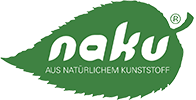
Material production – this is how natural plastic is created
Renewable raw materials as the basis for bioplastics
The basis for the material production of natural and biodegradable plastic is formed by renewable raw materials, which are processed into a compound through technical processing. Compound is a granulate that can then be further processed. Depending on the intended use, it is obtained either from corn starch or from lactic acid.
However, no bioplastic can be formed with starch or lactic acid alone: In the course of processing, a number of additives therefore have to be added. Typical substances used by NaKu for our natural plastic are, for example, minerals, resins, oils or sunflower waste. The sunflower pods naturally contain oils that act as a lubricant.
Gaining the starch (mainly corn starch at NaKu):
Starch is an organic compound that occurs naturally in many plants. In our part of the world, the raw materials used are primarily corn starch and potato starch. But there are also many other plants that produce starch, such as rice or Jerusalem artichoke.
More specifically, starch is a polysaccharide (multiple sugar). The corn starch is obtained by leaching. All starchy parts are further and further broken down and washed out of the cells by filtration and centrifugation steps until pure corn starch is obtained. After drying, the native corn starch is available as a powder. On an industrial scale, starch is used, for example, as a starting material for printer paper, glue, glue or the like.
production of lactic acid:
Lactic acid is a natural substance that occurs, for example, in yoghurt, sauerkraut or in the human body, for example in the muscles. The human organism can easily break down lactic acid, so as a natural plastic it is completely harmless.
The starting material for the production of lactic acid is the corn starch obtained from the corn plant. The lactic acid is obtained through fermentation. This means that the corn starch is fermented to lactic acid with the help of bacteria. Other products we use every day, such as sour milk products or yoghurt, are made using a similar process.
Polymerization to PLA:
In order to obtain a material like the compound for further processing, the lactic acid has to be polymerized. Lactide, a short-chain lactic acid compound, is converted to polylactide (PLA), a long-chain compound. This happens at high temperatures between 140 and 180°C and under the influence of catalytic tin compounds. This creates a thermoplastic material with high strength.
Compounding Process:
The thermoplastic raw material is still too sticky for further processing. The compounding process is used to obtain usable granules. This is a mixing process in which the individual components (thermoplastic raw material and additives such as minerals and oils) are mixed in the extruder. The extruder outputs a long line of natural plastic, which is then cut into granular form. The granules can be both starch and PLA or another raw material for bioplastics.
